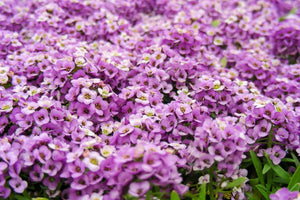How to Grow Four O’Clock Flowers From Seed for Easy Evening Blooms
If you’re looking for an easy-to-grow flower with a touch of timely magic, Four O’Clocks (Mirabilis jalapa) are a must-plant. These charming trumpet-shaped flowers open in the late afternoon and attract hummingbirds and nocturnal pollinators. There are many reasons to love this summer blooming flower.

Table of Contents
How to Grow Four O’Clock Flowers from Seed
Four O’Clock flowers can be directly sown into the garden after the danger of frost has passed. They’re fast growers and don’t require much to thrive, making them a fantastic choice for borders, containers, or informal garden beds.
We start our flower seeds indoors so that we can keep the soil warm. Once the summer temperatures have stabilized, we transplant the four o’clock seedlings out into the flower garden.
Tips for Fail-proof Four O’Clock Seed Germination
Before planting, scarify four o’clock seeds by knicking them with a knife or rubbing them with sandpaper and soaking them overnight.
Place seeds on the soil surface and gently press in; light is required for germination.
Soil temperature between 65-75ºF for germination.
Seeds should germinate in 7 to 14 days.
If starting seeds indoors, take time to harden off seedlings before planting them outdoors.

Growing and Caring for Four O’Clock Flowers
We’ve found caring for Four O’Clock flowers is fairly simple. They don’t require special treatment to keep them blooming all summer. Once established, Four O’Clocks are hardy and tolerant of various conditions. Also called “Marvel of Peru,” these flowers can be grown as a perennial in locations with mild winters and will grow 3 feet tall and 3 feet wide.
When temperatures dip below 30ºF, four o’clock plants will die off to the ground. As long as the roots don’t freeze, the plants will sprout again in the spring. Four O’Clocks will also grow from self-seeding.
Sun
Four O’Clock Flowers thrive in full sun. They can tolerate part sun if they get at least 6 hours of direct sunlight. As with most flowering plants, more sunshine will result in more blooms.
Soil
Water
Fertilizing
Harvesting
While not used as cut flowers due to their short bloom time, four o’clocks can be enjoyed in the garden daily. Seeds can be collected once the flower fades and a black seed forms.
In warm climates where it can be a perennial, prune four o’clock plants back to encourage new growth and keep them to size.

Pests and Diseases
Four O’Clocks are relatively pest-free but may occasionally attract aphids or spider mites. Treat with insecticidal soap if needed. Watch for signs of root rot in poorly drained soil.

Companion Plants for Four O'Clocks
Here’s a fun garden idea that’s especially great for kids! Try planting four o’clocks alongside morning glories, sunflowers, and moonflowers to create a garden that tracks the sun’s movement throughout the day.
Morning glories open with the sunrise, sunflowers follow the sun across the sky, and Four O’Clocks wait until late afternoon to bloom—often around 4 p.m. However, the exact time depends on temperature and location. Moonflowers join in after dark, making this collection a beautiful way to observe how different flowers respond to light.
Four O’Clock flowers are the evening counterpart to morning glories. Their trumpet-shaped blooms open as the sun dips lower, releasing a light fragrance that draws in pollinators. Like moonflowers, each bloom lasts just one evening, but they stay on the plant for a while. You don’t need to deadhead them to keep the plant blooming, but you can pick off spent blooms if you prefer a cleaner look.
It’s also important to note that Four O’Clocks are deer and rabbit-resistant. Most likely, it is because all parts of the plant are toxic if eaten.
In warmer climates (zones 9 and up), Four O’Clocks can grow as perennials. In colder regions, they’re grown as annuals, but they’ll often reseed themselves for a surprise return next year.

Four O’Clock Flowers FAQs
Do Four O’Clock Flowers come back every year?
In growing zones where the roots don’t freeze, four o’clock flowers will come back. They can also self-sow. New plants will emerge in summer when the soil warms up.
Do Four O’Clock Flowers spread?
What colors do Four O’Clocks come in?
Four O’Clock flowers can be white, pink, red, or yellow. They can even be different colors on the same plant. They cross-pollinate easily, and if you save seed , you’ll see color changes over time.
Are Four O’Clock Flowers annual or perennial?
When do four o’clocks bloom?
Four O’Clock Flowers will start blooming in summer when temperatures are warm. The individual flowers unfurl into their full trumpet shape around 4 pm each day. This time isn’t exact and depends on the sunlight.
Are four o’clocks safe around pets?
Caution: All parts of the Mirabilis jalapa plant are considered toxic if ingested. Keep away from pets that like to chew plants.

Fun Facts About Four O'Clocks
Timekeepers of the Garden: These flowers open in the late afternoon (around 4 p.m.) and close by morning—hence the name!
World Travelers: Native to Peru and once cultivated by the Aztecs, they were introduced to Europe in the 1500s and quickly spread worldwide. They were noted as growing in Mt Vernon Gardens in 1767.
Nature’s Paint Palette: It’s common to see different colored blooms—pink, yellow, white, and red—on the same plant or even the same flower. This is due to a rare genetic trait called mosaicism.
Science Stars: Four O'Clocks helped scientists discover cytoplasmic inheritance, showing that traits could be passed through cell components outside the nucleus.
If you want a flower garden with a variety of bloom times and colors, plant Four O’Clocks. These tropical flowers will give you a beautiful evening garden that attracts hummingbirds and other pollinators who love trumpet-shaped blooms. With their easygoing nature, four o'clock flowers can be added to cottage and wildflower gardens. Try this beautiful heirloom flower in your garden.
Popular Posts
-

Top 15 Vegetables to Grow for Food Pantry Donations
-

Grow Sweet Alyssum from Seed, the Filler Flower You'll Want Everywhere






Leave a comment